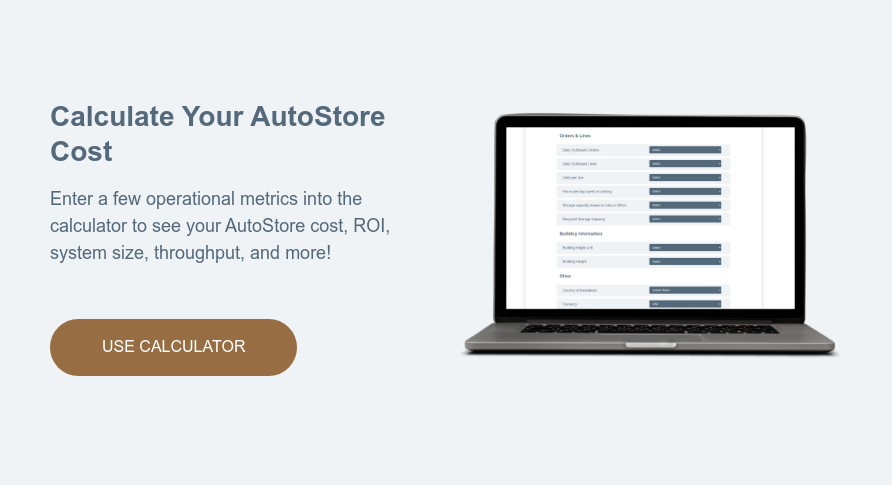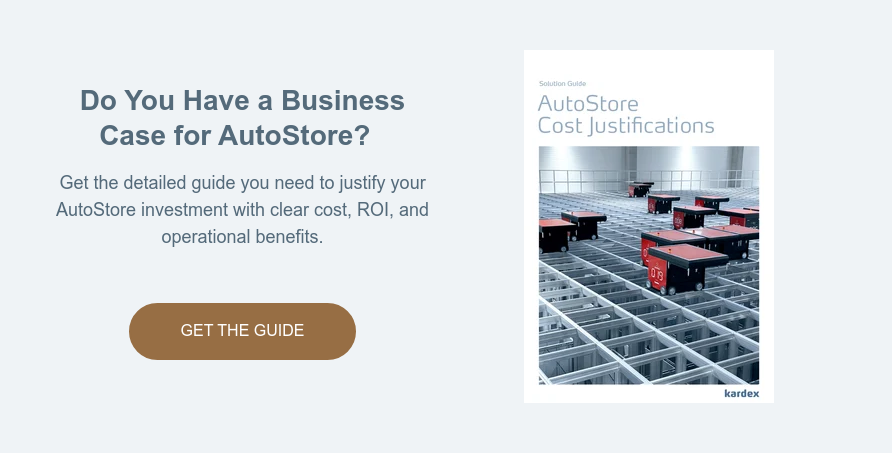Automating your warehouse is a big investment. Before you commit, it’s important to clearly understand the costs, expected savings, and how long it will take to pay off.
Key financial metrics like ROI, payback period, and internal rate of return help you see whether an AutoStore system makes sense for your operation.
In this post, I’ll break down what these metrics mean and how to use them to evaluate an AutoStore installation.
Topics covered in this blog:
How to Calculate AutoStore ROI, Payback Period & IRR
Investing in warehouse automation can be a game-changer for e-commerce companies, third-party logistics providers, omnichannel retailers, or any business that operates out of a warehouse. But understanding the financial impact is crucial before making such a decision. When evaluating warehouse automation like AutoStore, three key financial metrics often come up: Return on Investment (ROI), Payback Period, and Internal Rate of Return (IRR).
Let’s break these down using a practical example:
Example Investment:
You decide to purchase an AutoStore system for $1,000,000. After implementing the system, you find that it saves you $300,000 per year in labor and operational costs. Over five years, these savings total $1,500,000.
Return on Investment (ROI)
ROI is one of the simplest and most common ways to evaluate an investment. It tells you how much profit you can expect to make from your investment relative to its cost. In other words, it’s a way to measure how effectively your money is being used.
Calculating the net profit:
Net Profit = Total Savings – Investment Cost
Net Profit = $1,500,000 - $1,000,000
Net Profit = $500,000
Calculating the ROI:
ROI = Net Profit / Investment Cost x 100
ROI = $500,000 / $1,000,000 x 100
ROI = 50%
ROI Summary:
This means the ROI for this investment example is 50%, showing that you're making back your original money plus an extra 50% in profit.
Payback Period
The payback period tells you how long it will take to recover the initial investment from the cash savings or profit generated by the investment. It’s essentially the amount of time it takes for your investment to "pay for itself."
Using the same AutoStore investment example from above, remember that the system saves you $300,000 per year. So, let's calculate how long it will take for the investment to pay for itself.
Calculating the payback period:
Payback Period = Investment Cost / Annual Savings or Profit
Payback Period = $1,000,000 / $300,000
Payback Period = 3.33 years
Payback Period Summary:
Continuing with our example, it would take just over 3.33 years (3 years and 4 months) to recover your initial investment.
Internal Rate of Return (IRR)
IRR is a bit more complex but extremely useful. It measures the annualized rate of return expected from an investment over a specific period. IRR is like asking:
"If my AutoStore savings were an interest rate, what rate would make it a fair trade for my upfront cost?"
How IRR Works:
IRR is the interest rate that makes the net present value (NPV) of all your cash flows (both the cost and the savings over time) equal to zero.
- If you think of future savings like a stream of payments, IRR is the discount rate that makes those future savings "worth" exactly what you paid upfront
- It helps you compare investments with different timelines or payment structures on an equal footing
Calculating IRR:
IRR isn't calculated with a simple formula like ROI. Instead, you typically use:
- Financial calculators
- Spreadsheet functions (like Excel's =IRR())
- Specialized software
These tools iterate to find the exact rate that balances your investment cost and all expected cash flows.
Continuing with our example, the AutoStore system costs $1,000,000 upfront and saves $300,000 each year for 5 years. By plugging these cash flows and the initial investment into an IRR formula, you find that the IRR is 18%. This means that the investment in the ASRS yields an 18% annual return over the five years.
IRR Summary:
In the example, the AutoStore system costs $1,000,000 upfront and saves $300,000 each year for 5 years
Putting It All Together
- ROI gives you a percentage that indicates the overall profitability of the investment. In our example, a 50% ROI means you’re getting half of what you invested back in profit.
- Payback Period tells you how quickly you’ll recoup your investment. In this case, it’s just over three years.
- IRR provides the annual rate of return over the investment’s lifespan, accounting for the time value of money. An 18% IRR means you’re earning an equivalent of 18% per year from your investment.
These metrics each provide a different perspective, helping you understand the profitability, risk, and timeline of your investment. When combined, they give a fuller picture, ensuring that your decision to invest in warehouse automation aligns with your financial goals.
How Much Does an AutoStore System Cost?
It's important to note that the cost of an AutoStore system widely varies across use-cases. For example, a small system in the back of a retail store might cost $1,000,000 whereas a complex setup supporting omnichannel fulfillment for a multi-national distribution center could cost upwards of $50,000,000. On average, I'd say that many AutoStore systems cost between $3,000,000 - $6,000,000.
What Factors Impact the Cost?
Investing in an AutoStore system means understanding what you need to build AND what it takes to deploy it successfully. Factors that impact the cost generally break down into two main categories: system requirements and implementation costs.
System Requirements:
- Inventory Capacity: The variety and volume of inventory you plan to store will determine the grid size and the number of bins required. Larger grids mean higher material and installation costs.
- Required Throughput: The speed and volume of order processing you need will determine how many robots and workstations are required.
- Software: Includes licenses for the AutoStore control software and any additional warehouse execution software (like Kardex FulfillX) needed to manage and optimize system operations.
- Performance Add-Ons: Optional modules like the grid-cleaning robot, FulfillX, CarouselAI (robotic bin picking), or the Intuitive Picking Assistant (IPA) can be deployed to boost efficiency.
Implementation Costs
- Delivery: Accounts for transporting all system components to your site.
- Installation: Encompasses assembling the grid, setting up robots and ports, inducting the bins, and ensuring the physical system is correctly installed at your facility.
- Integration: Connecting AutoStore to your existing WMS/ERP systems, customizing workflows, and ensuring smooth data exchange.
- Facility Modifications: Includes any changes required to your building to support the system like leveling the floor, upgrading power supply, or minor structural adjustments. But, compared to other ASRS solutions, AutoStore can be configured around columns, above walkways, or even between floors, often requiring minimal changes to your facility layout.
Estimating Your AutoStore Cost
You may be wondering, "OK, so what would it cost to put AutoStore into my facility?"
Good news! There's a free, online tool you can use to calculate your AutoStore cost: StoreX Calculator.
Simply enter a few of your operational metrics (building height, SKU count, orders per day, etc.) and it will generate an estimated system size, cost (system + implementation), projected return on investment, and more.
What Is the ROI of an AutoStore Investment?
A well-designed AutoStore system typically delivers a positive ROI with a payback period of just 2–3 years.
In some cases, many third-party logistics providers can see a return on investment from day one by leveraging a leasing strategy.
Below, I'll detail a combination of predictable initial costs and substantial long-term savings that contribute to the ROI.
Initial Costs
As I mentioned in the previous section on costs, understanding your initial investment is the first step. But to really evaluate ROI, you need to consider the savings and efficiencies that pay that investment back over time.
Long-Term Savings
AutoStore delivers significant savings that pay back the initial investment within 2-3 years. These savings come from clear, measurable factors like labor, space utilization, and operational efficiency, but also from less obvious advantages that further boost ROI.
The obvious, quantifiable factors are:
- Labor Efficiency: One of the most significant factors influencing ROI is labor efficiency. With AutoStore, employees can handle three times as much work, resulting in over 50% labor cost savings.
- Space Utilization: Automation can significantly optimize space usage, potentially eliminating the need for costly facility expansions or relocations, leading to substantial savings on construction and lease expenses.
- Picking Accuracy: AutoStore’s automated system is designed to be precise and reliable, helping you pick the right items every time. With fewer errors and improved order accuracy, you’ll keep customers happy while cutting down on costly returns and reshipments. Plus, the Intuitive Picking Assistant makes the whole process even easier for operators, reducing mistakes and cutting down on new-hire training time. All of this adds up to real savings and a better ROI.
Did you know?
A recent study found that distribution centers in the United States are losing an average of nearly $390,000 per year due to mispicked orders.
And the less-obvious factors that have significant impact are:
- Construction and Lease Savings: AutoStore reduces the storage footprint you need in your existing warehouse. That means you can fit more SKUs or free up space for packing, shipping, or other operations without building an addition or leasing extra space.
- Ease of System Management: With FulfillX software, system management becomes significantly simpler. The software eliminates the need for manual creation of wave order releases, automating the entire process. It efficiently handles all tasks within the system, requiring minimal intervention or oversight.
- Predictability: Furthermore, the predictability of the system's output allows for precise scheduling and efficient resource allocation. For example, if you know for a fact that the AutoStore system can present 1,000 bins per hour, and you have 3,000 picks to perform, you know it will take 3 hours to complete the picks. Therefore, you can schedule and allocate appropriate resources more accurately.
- Secured Storage: The AutoStore system ensures secure inventory storage, significantly reducing the risk of lost or stolen items. Warehouse employees can only access inventory when a bin is presented at the port, making it virtually impossible for items to go missing.
- Fewer Injuries: Ergonomic design helps maintain natural postures, lowering the likelihood of musculoskeletal disorders and repetitive strain injuries. Consequently, there are fewer workplace injuries, leading to lower healthcare costs, reduced absenteeism, and increased productivity. The combined effect of these benefits directly enhances ROI, making ergonomic picking stations a valuable investment for any warehouse operation.
- Scalability: AutoStore’s modular, flexible design lets you expand capacity or reconfigure layouts as demand, SKUs, or order fulfillment channels change. This avoids the need for expensive system replacements, big building expansions, or major new investments down the road.
- System Reliability: AutoStore’s high reliability and 99.7% uptime minimize unplanned downtime, ensuring workers can stay productive without costly interruptions. By maintaining continuous operations, AutoStore reduces the risk of delayed or missed order fulfillment, protecting revenue and customer satisfaction.
- Customer Relationships: When orders go out on time and with fewer mistakes, customers stay happy. AutoStore helps you deliver quickly and accurately, cutting down on returns and keeping your reputation solid.
Comparing ASRS Solutions
Want to see how AutoStore’s ROI stacks up against other ASRS technologies? Check out our complete guide to ASRS cost and ROI comparisons. We break down cube-based systems, AMR solutions, and aisle-based ASRS so you can choose the best fit for your operation.
Is AutoStore Right For You?
I understand that choosing to automate your storage and retrieval processes is a huge decision and large investment, and my goal is to help you decide which solution is right for your operation. I don't sell a solution for the sake of selling a solution..I sell a solution if the business case makes sense for you. To better understand if AutoStore (or other Kardex solutions) are right for you, contact us.






